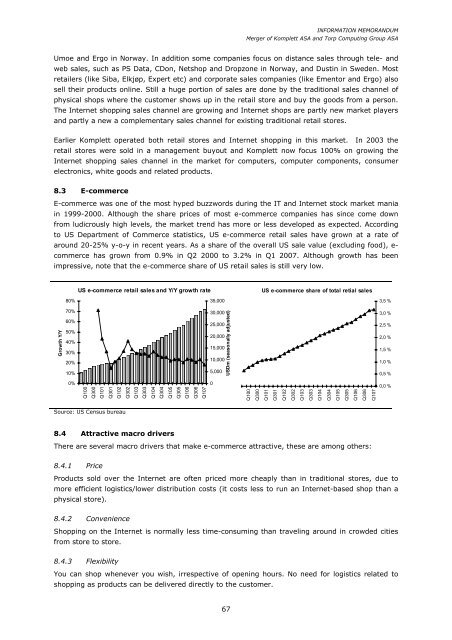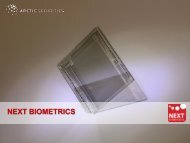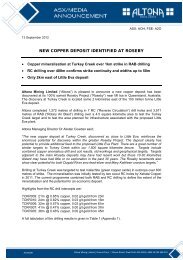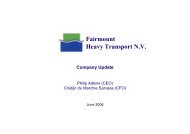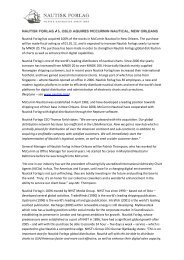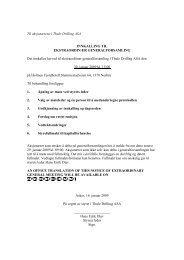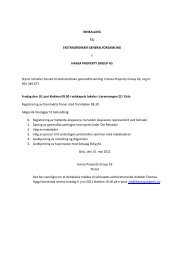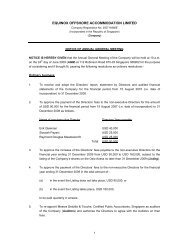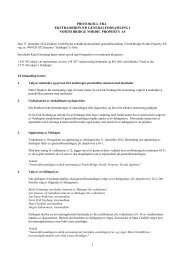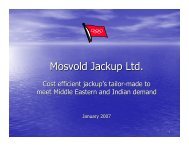Torp Computing Group ASA
Torp Computing Group ASA
Torp Computing Group ASA
You also want an ePaper? Increase the reach of your titles
YUMPU automatically turns print PDFs into web optimized ePapers that Google loves.
67<br />
INFORMATION MEMORANDUM<br />
Merger of Komplett <strong>ASA</strong> and <strong>Torp</strong> <strong>Computing</strong> <strong>Group</strong> <strong>ASA</strong><br />
Umoe and Ergo in Norway. In addition some companies focus on distance sales through tele- and<br />
web sales, such as PS Data, CDon, Netshop and Dropzone in Norway, and Dustin in Sweden. Most<br />
retailers (like Siba, Elkjøp, Expert etc) and corporate sales companies (like Ementor and Ergo) also<br />
sell their products online. Still a huge portion of sales are done by the traditional sales channel of<br />
physical shops where the customer shows up in the retail store and buy the goods from a person.<br />
The Internet shopping sales channel are growing and Internet shops are partly new market players<br />
and partly a new a complementary sales channel for existing traditional retail stores.<br />
Earlier Komplett operated both retail stores and Internet shopping in this market. In 2003 the<br />
retail stores were sold in a management buyout and Komplett now focus 100% on growing the<br />
Internet shopping sales channel in the market for computers, computer components, consumer<br />
electronics, white goods and related products.<br />
8.3 E-commerce<br />
E-commerce was one of the most hyped buzzwords during the IT and Internet stock market mania<br />
in 1999-2000. Although the share prices of most e-commerce companies has since come down<br />
from ludicrously high levels, the market trend has more or less developed as expected. According<br />
to US Department of Commerce statistics, US e-commerce retail sales have grown at a rate of<br />
around 20-25% y-o-y in recent years. As a share of the overall US sale value (excluding food), ecommerce<br />
has grown from 0.9% in Q2 2000 to 3.2% in Q1 2007. Although growth has been<br />
impressive, note that the e-commerce share of US retail sales is still very low.<br />
Growth Y/Y<br />
80%<br />
70%<br />
60%<br />
50%<br />
40%<br />
30%<br />
20%<br />
10%<br />
0%<br />
US e-commerce retail sales and Y/Y growth rate<br />
Q100<br />
Q300<br />
Q101<br />
Q301<br />
Q102<br />
Source: US Census bureau<br />
Q302<br />
Q103<br />
Q303<br />
Q104<br />
Q304<br />
Q105<br />
Q305<br />
Q106<br />
Q306<br />
Q107<br />
35,000<br />
30,000<br />
25,000<br />
20,000<br />
15,000<br />
10,000<br />
5,000<br />
0<br />
USDm (seasonally adjusted)<br />
US e-commerce share of total retial sales<br />
8.4 Attractive macro drivers<br />
There are several macro drivers that make e-commerce attractive, these are among others:<br />
8.4.1 Price<br />
Products sold over the Internet are often priced more cheaply than in traditional stores, due to<br />
more efficient logistics/lower distribution costs (it costs less to run an Internet-based shop than a<br />
physical store).<br />
8.4.2 Convenience<br />
Shopping on the Internet is normally less time-consuming than traveling around in crowded cities<br />
from store to store.<br />
8.4.3 Flexibility<br />
You can shop whenever you wish, irrespective of opening hours. No need for logistics related to<br />
shopping as products can be delivered directly to the customer.<br />
Q100<br />
Q300<br />
Q101<br />
Q301<br />
Q102<br />
Q302<br />
Q103<br />
Q303<br />
Q104<br />
Q304<br />
Q105<br />
Q305<br />
Q106<br />
Q306<br />
Q107<br />
3,5 %<br />
3,0 %<br />
2,5 %<br />
2,0 %<br />
1,5 %<br />
1,0 %<br />
0,5 %<br />
0,0 %


